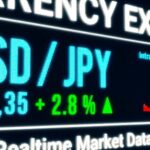US Dollar Turns Flat as Geopolitical Uncertainty Overshadows Markets.
The US Dollar Index (DXY) steadied around the 100.00 mark on Tuesday after briefly dipping lower, as investors grappled with intensifying global tensions and erratic US foreign policy moves. Amid scarce domestic economic data, all eyes remain on a parade of Federal Reserve speakers for any clues on future monetary policy.
Dollar Struggles to Hold Ground
After a brief test below the symbolic 100.00 level, the DXY stabilized, but the broader market sentiment remains fragile. Recent developments — from geopolitical escalations to questions over US leadership on the global stage — have dulled investor appetite for the Greenback. Despite holding slightly above the 100.00 line for now, the index remains vulnerable to further declines, potentially revisiting levels last seen in 2022.
Trump’s Comments Shake Global Confidence
A major contributor to the Dollar’s wobble came from US President Donald Trump’s stark announcement on Monday. Following a two-hour phone call with Russian President Vladimir Putin, Trump declared that the US would step back from further participation in peace talks surrounding the Russia-Ukraine conflict.
His blunt statement — “it’s not our war to deal with” — stirred disapproval across the Atlantic. EU leaders, already skeptical of US commitment to European security, expressed concern over the retreat. With the US now appearing unreliable in key geopolitical negotiations, the Dollar’s reputation as a global safe haven is showing signs of erosion.
Geopolitical Risks Rise as Israel Crisis Deepens
Beyond Eastern Europe, tensions in the Middle East are further roiling market sentiment. France, the UK, and Canada are reportedly weighing sanctions against Israel if it does not halt its military ground offensive in Gaza and allow humanitarian aid through.
Israeli Prime Minister Benjamin Netanyahu responded defiantly, asserting Israel’s right to self-defense. These developments, while not directly tied to the US Dollar, contribute to an overall climate of global uncertainty, limiting risk appetite and complicating FX flows.
Fed Commentary Becomes Market Focus
With a light economic calendar this week, the spotlight turns to the Federal Reserve’s communication schedule. Several key Fed officials are set to speak Tuesday, offering potential insights into the path of monetary policy. On Monday, many Fed voices leaned hawkish, and traders will be looking to see if this tone is sustained.
Here’s a rundown of Tuesday’s Fed speakers:
- 13:00 GMT: Richmond Fed President Thomas Barkin speaks on economic growth in rural America.
- 17:00 GMT: St. Louis Fed President Alberto Musalem appears at the University of Minnesota.
- 21:00 GMT: Fed Governor Adriana Kugler delivers a commencement speech at UC Berkeley.
- 23:00 GMT: A panel discussion at the Atlanta Fed’s 2025 Financial Markets Conference will feature:
- Atlanta Fed President Raphael Bostic
- San Francisco Fed President Mary C. Daly
- Cleveland Fed President Beth M. Hammack
Each of these appearances could sway market expectations, especially if new comments diverge from recent Fed guidance.
Equity Markets Caught Between Optimism and Fear
US equity futures are under slight pressure, while European markets edge cautiously higher. The German DAX touched yet another all-time high, buoyed by strong earnings and stable inflation expectations in the eurozone.
The divergence in equity sentiment underscores the regional dislocations emerging from differing central bank policies and political risks. European equities may be benefiting from renewed optimism around EU resilience, while US markets appear weighed down by political risk premiums and limited economic momentum.
Rate Cut Hopes Dim for June, Eyes Turn to July
According to the CME FedWatch Tool, markets are increasingly skeptical of any rate move by the Federal Reserve in June. The probability of a rate cut next month stands at just 8.6%. However, expectations for July show a slightly higher chance — 33.1% — that the Fed may begin cutting interest rates by then.
This cautious outlook aligns with Fed officials’ insistence that inflation must demonstrate more sustained progress toward the 2% target before policy easing can be justified.
Bond Yields Remain Elevated
US Treasury yields continue to hover at elevated levels. The 10-year yield briefly dipped Tuesday morning but bounced back to around 4.48%, reflecting persistent inflationary concerns and waning hopes for an imminent rate cut. The yield curve remains deeply inverted — a signal that recessionary risks remain in play, even if delayed.
Global Dollar Demand Faces a Credibility Test
Recent remarks by President Trump have exposed the Dollar to the geopolitical credibility premium — or lack thereof. For decades, the USD’s global dominance has rested not only on economic might but on the US’s perceived role as a stabilizing global force. Trump’s statement marks a departure from this image.
If investors begin questioning the reliability of US foreign policy, especially in multilateral frameworks like NATO or the UN, the appeal of the Dollar as a reserve currency may diminish over time. Although it’s premature to forecast a structural shift away from the USD, the short-term signals suggest a weakening of the Greenback’s soft power.
Technical Picture: DXY Faces Key Tests Ahead
From a technical perspective, the Dollar Index is navigating a critical support zone. A sustained move below the 100.00 level could open the door to a test of 98.70, the December 2022 low. Resistance remains at 100.75 and 101.30, while momentum indicators show waning bullish energy.
Traders are likely to remain cautious ahead of Fed commentary and any additional geopolitical headlines. A clear break in either direction could result in an outsized move, given the current low-volatility environment.
[faq-schema id=”39630″]









